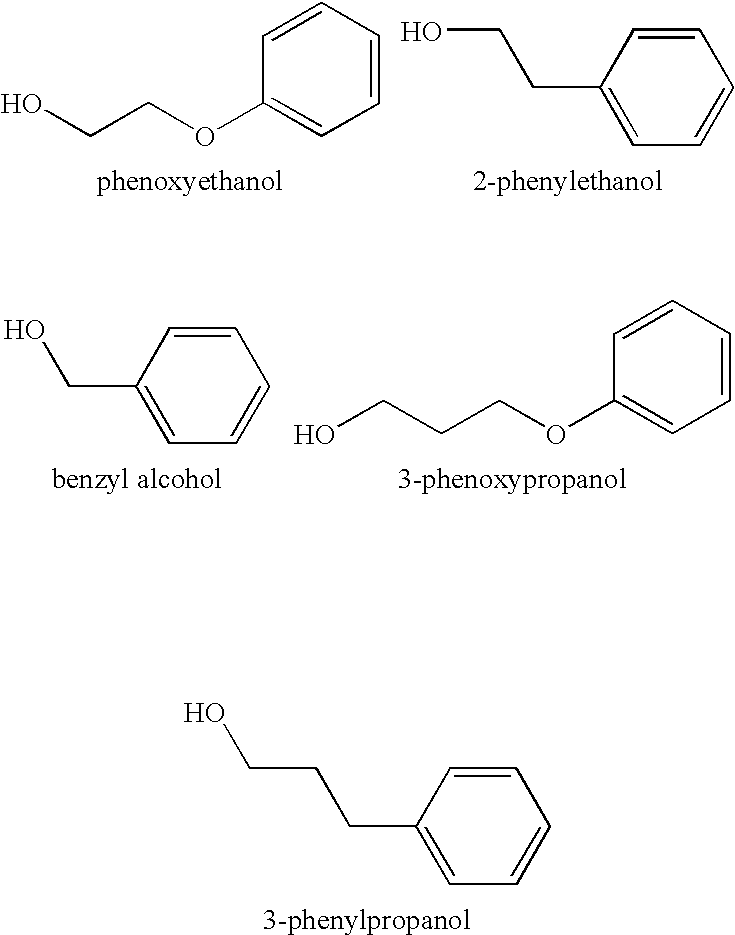Antimicrobial compositions
- Summary
- Abstract
- Description
- Claims
- Application Information
AI Technical Summary
Benefits of technology
Problems solved by technology
Method used
Image
Examples
example 2
Sporicidal Effect of Test Compounds and Preservatives in a Cosmetic Cream
[0090]A cosmetic cream (pH 5.5) for application to the human skin is formulated as follows (in % w / w):
[0091]
Glyceryl-monostearate3Glycerine5Xanthan gum0.25Stearic acid7Sweet almond oil4Glyceryl dilaurate1Cetyl-stearyl-alcohol2L-Arginine0.5Wateradd 100
[0092]Glyceryl-monostearate, Sweet almond oil, Cetyl-stearyl-alcohol and Glyceryl dilaurate are melted at 80° C. Xanthan gum is dispersed into glycerine. Arginine is dissolved in water and heated to 75° C. The Xanthan gum-glycerin suspension is added to the heated water phase, the heated oil phase is added and the suspension is stirred at 300 rpm for 10 min whilst being cooled down slowly. Finally, a homogeneous emulsion is made with a high speed homogenizer at 5000 rpm.
[0093]Test samples of cream contain different amounts of preservatives and / or preservative enhancer. The preservative and preservative enhancer is added to an aliquot of 10 g of the cream in 50 ml t...
example 3
Enhanced Sporicidal Effect of Preservative Compounds in Cosmetic Cream
[0099]The sporidical effect in cream (prepared as described in example 2) is compared when using the test compounds alone or in combination with phenoxyethanol, benzyl alcohol or 2-Phenylethanol.
[0100]Table 3 shows the sporicidal effect of test compounds in the presence of various preservatives (phenoxyethanol, benzyl alcohol or 2-Phenylethanol).
[0101]
TABLE 3Sporicidal effect of test compounds and various preservativesSpores / mlReductionTest compoundPreservativeafter 7 dfactornonenone1.04 × 105 nonePhenoxyethanol 0.5%6.8 × 1041.5none2-Phenylethanol 0.5%4.2 × 1042.5none2-Phenylethanol 0.25% +2.12 × 104 4.9benzylalcohol 0.25%none2-Phenylethanol 0.5% +4.8 × 10321.7benzylalcohol 0.5%4-methoxybenzaldehyde 0.1%none2.8 × 10337.1Vanilline 0.1%none 1 × 10410.44-hydroxybenzaldehyde 0.1%none1.0 × 1051.044-hydroxy-2-methoxy-benzaldehydenone2.08 × 104 53,5-dihydroxybenzaldehydenone 1 × 104104-methoxybenzaldehyde 0.1%Phenoxyet...
example 4
Broad Band Activity Against Bacteria, Yeast and Mold Spores in Cosmetic Cream
[0103]As test organisms Staphylococcus aureus (DSMZ 799) and Pseudomonas aeruginosa (ATCC 15442) are used. The strains are grown overnight in Mueller-Hinton broth and adjusted to a cell density of 1×108 cfu (colony forming units) per ml.
[0104]The two bacterial strains are mixed in a ratio of 1:1 and 100 μl of this mixed inoculum is added to 10 ml aliquots of the cosmetic cream supplemented with test compounds as described in Example 2 in the concentration as indicated in the table below.
[0105]The resulting mixtures are incubated at room temperature and at the regular intervals samples are removed, suspended in neutralizer solution and diluted as described above (example 2).
[0106]Aliquots of these suspended and diluted samples are plated on tryptic soy agar supplemented with 0.5% Tween 80 and then incubated for 24 h at 37° C. Surviving bacteria are counted.
[0107]The same procedure as described above except f...
PUM
| Property | Measurement | Unit |
|---|---|---|
| Fraction | aaaaa | aaaaa |
| Fraction | aaaaa | aaaaa |
| Fraction | aaaaa | aaaaa |
Abstract
Description
Claims
Application Information
 Login to View More
Login to View More - R&D
- Intellectual Property
- Life Sciences
- Materials
- Tech Scout
- Unparalleled Data Quality
- Higher Quality Content
- 60% Fewer Hallucinations
Browse by: Latest US Patents, China's latest patents, Technical Efficacy Thesaurus, Application Domain, Technology Topic, Popular Technical Reports.
© 2025 PatSnap. All rights reserved.Legal|Privacy policy|Modern Slavery Act Transparency Statement|Sitemap|About US| Contact US: help@patsnap.com



